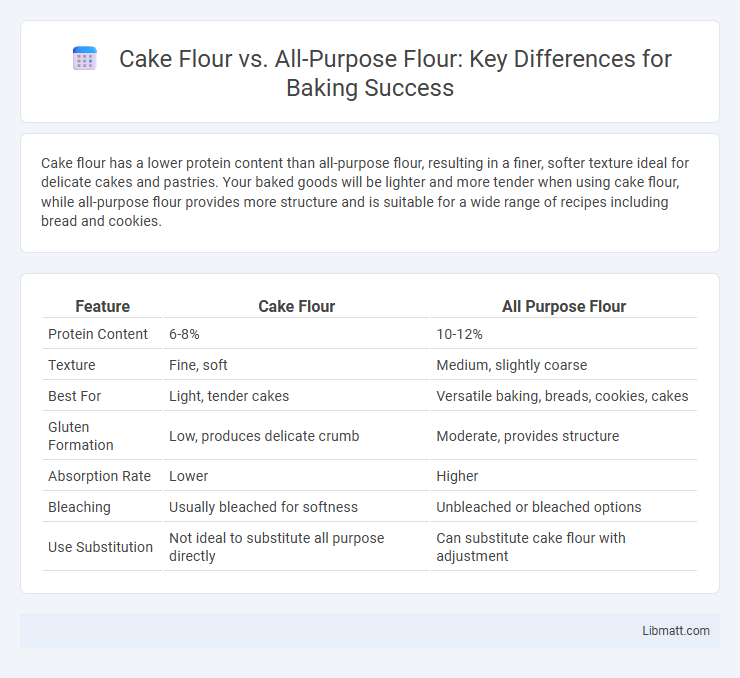Cake flour has a lower protein content than all-purpose flour, resulting in a finer, softer texture ideal for delicate cakes and pastries. Your baked goods will be lighter and more tender when using cake flour, while all-purpose flour provides more structure and is suitable for a wide range of recipes including bread and cookies.
Table of Comparison
| Feature | Cake Flour | All Purpose Flour |
|---|---|---|
| Protein Content | 6-8% | 10-12% |
| Texture | Fine, soft | Medium, slightly coarse |
| Best For | Light, tender cakes | Versatile baking, breads, cookies, cakes |
| Gluten Formation | Low, produces delicate crumb | Moderate, provides structure |
| Absorption Rate | Lower | Higher |
| Bleaching | Usually bleached for softness | Unbleached or bleached options |
| Use Substitution | Not ideal to substitute all purpose directly | Can substitute cake flour with adjustment |
Introduction to Cake Flour and All Purpose Flour
Cake flour is a finely milled, low-protein flour typically containing 7-9% protein, designed to create tender, delicate baked goods such as cakes and pastries. All purpose flour, with a moderate protein content of around 10-12%, offers versatility for a wide range of recipes including breads, cookies, and cakes. The primary differences between cake flour and all purpose flour lie in their protein levels and milling processes, which directly affect gluten development and final texture in baked products.
What is Cake Flour?
Cake flour is a finely milled, low-protein flour containing about 7-8% protein, which results in a tender, soft crumb ideal for delicate baked goods. Its lower gluten content compared to all-purpose flour prevents toughness and promotes a lighter texture in cakes and pastries. Often bleached to improve whiteness and baking performance, cake flour absorbs more liquid and sugar, enhancing moisture and overall cake volume.
What is All Purpose Flour?
All-Purpose Flour is a versatile baking staple made from a blend of hard and soft wheat, offering a protein content typically between 10-12%, which provides a balanced structure suitable for a wide range of baked goods. This flour is ideal for recipes where moderate gluten development is desired, such as cookies, muffins, and quick breads, delivering a texture that is neither too dense nor too tender. When choosing flour for your baking needs, understanding that All-Purpose Flour serves as a flexible option helps you achieve consistent results across various recipes.
Key Differences Between Cake Flour and All Purpose Flour
Cake flour has a lower protein content, typically around 7-8%, compared to all-purpose flour's 10-12%, resulting in a finer, softer crumb ideal for delicate cakes. Its finely milled texture and lower gluten formation help produce tender, moist baked goods, while all-purpose flour provides more structure and versatility for a wide range of recipes. Understanding these differences ensures your baked creations achieve the desired texture and rise, enhancing your baking outcomes.
Protein Content Comparison
Cake flour typically contains 7-9% protein, which produces a tender, delicate crumb perfect for cakes and pastries. All-purpose flour has a higher protein content, usually between 10-12%, lending more structure and chewiness ideal for a wide range of baked goods. Understanding these differences helps you choose the right flour to achieve your desired texture and consistency in baking.
Best Uses for Cake Flour
Cake flour is best used for making tender, delicate baked goods such as chiffon cakes, sponge cakes, and soft pastries due to its lower protein content compared to all-purpose flour. Its fine texture and lower gluten formation result in lighter, fluffier cakes with a velvety crumb that enhances the overall dessert experience. Using cake flour will improve your recipes that require a softer, more airy structure, perfect for achieving professional-quality cakes.
Best Uses for All Purpose Flour
All Purpose Flour is ideal for versatile baking recipes, including cookies, breads, muffins, and pancakes, due to its moderate protein content of about 10-12%. It provides a balanced gluten structure that achieves a tender yet sturdy texture, making it suitable for most baked goods. Home bakers and professionals prefer All Purpose Flour when a flexible flour option is needed for both delicate and robust recipes.
How to Substitute Cake Flour for All Purpose Flour
To substitute cake flour for all-purpose flour, use 1 cup of cake flour plus 2 tablespoons of cornstarch to replace 1 cup of all-purpose flour, ensuring a lighter texture in your baked goods. Cake flour has lower protein content, which creates tenderness perfect for delicate cakes but may affect structure in recipes requiring gluten strength. Adjust liquid ingredients slightly if your batter appears thinner, preserving your recipe's consistency and desired crumb.
Baking Results: Texture and Flavor Differences
Cake flour produces baked goods with a tender, delicate crumb and a softer texture due to its lower protein content compared to all-purpose flour, which results in less gluten formation. All-purpose flour yields denser, chewier textures with a more robust flavor, making it suitable for a wide range of recipes but less ideal for light cakes. Your choice between the two flours will directly impact the fluffiness and taste of your baked treats, with cake flour enhancing softness and subtle flavor while all-purpose provides structure and depth.
Which Flour Should You Choose?
Cake flour has a lower protein content, typically around 7-8%, making it ideal for tender, delicate baked goods like cakes and pastries. All-purpose flour contains 10-12% protein, providing more structure and chewiness, suitable for a wide range of recipes including bread, cookies, and muffins. Choose cake flour for soft, airy textures and all-purpose flour for versatility and balanced results in your baking.
Cake Flour vs All Purpose Flour Infographic

 libmatt.com
libmatt.com